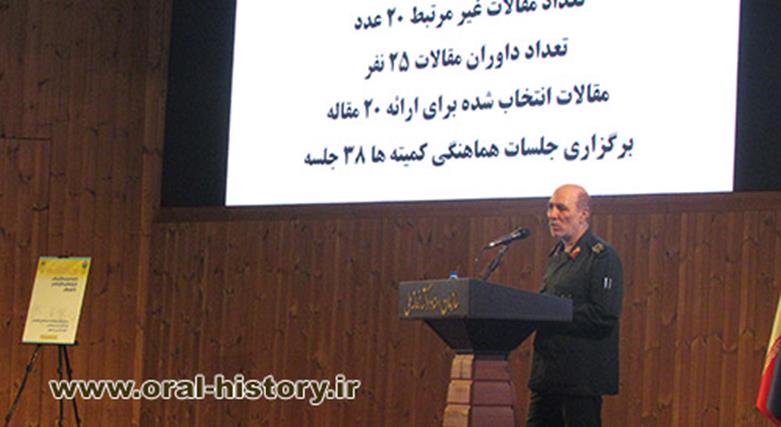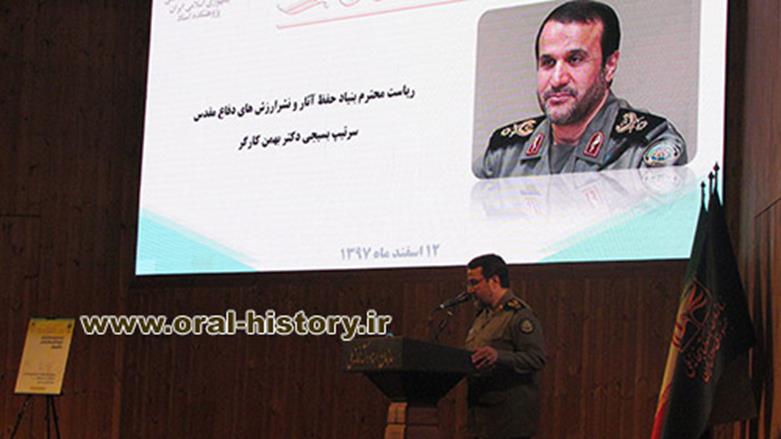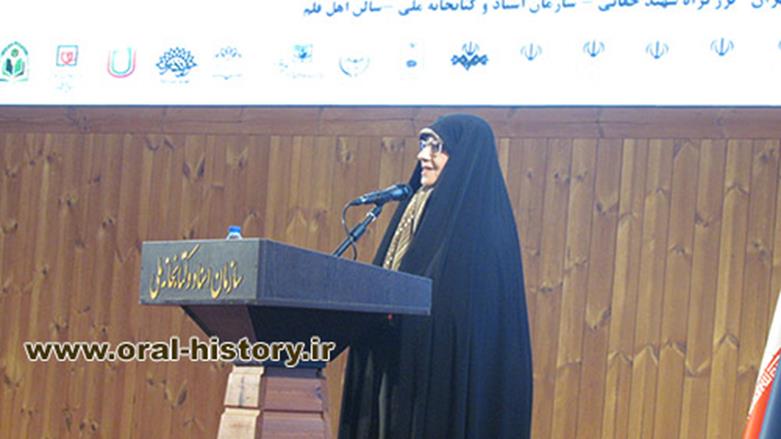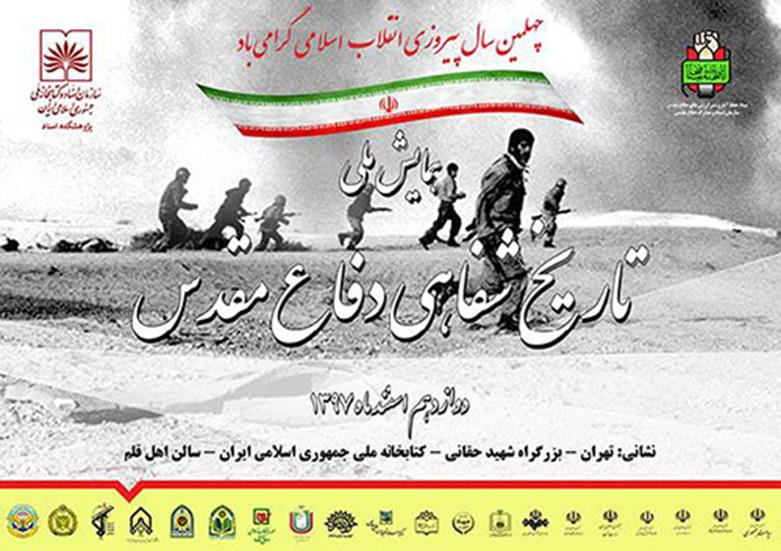The Second National Conference on Oral History of Holy Defense -1
The Purpose Is to Explain Events and Prevent Them from Distortion
Maryam Rajabi
Translated by Ruhollah Golmoradi
2019-4-23
As reported by Iranian Oral History Website Iran, the 2nd National Conference on Oral History of Holy Defense was started in Ahle Ghalam Hall of NLAI in the morning of Sunday, March 3, 2019.
A review of the conference process
Second Brigadier General Pasdar (IRGC's officer) Gholamreza Alamati, head of the Organization of Holy Defense Documents and Proofs and secretary of the conference, stated at the beginning of the session, "oral history of the sacred defense means gathering personal memories and experiences of those who were present in this great event and the great incident, and as a first-hand historical document can be used. For the sake of that we can record and institutionalize this great event, like the holy defense, it would be necessary all organizations and agencies can participate collectively in this process. Holding the national conference of Oral History is one of the steps taken to explain those incidents and prevent them from distortion and extinction.

The conference was targeted at five axes: theoretical foundations, oral history of necessities and opportunities, policies and role of military and civilian organizations that each has sub-axis, pathology and barriers oral history faces and other issues related to the holy defense. Two main organizations, one of them is the Organization of Holy Defense Documents and Proofs and other is Research Institute of Documents and NLAI, with participation of twenty organizations tried to do this mighty move together. Eight people were selected for membership in the Scientific Committee, and 141 articles were received at the conference, which were evaluated. Each article was given to two referees, and when the two referees disagreed, the article was given to the third referee in order to have a good and proper evaluation of the articles; 25 referees did it. Finally, 20 papers were selected that will be presented in three panels. In order to do this, 38 coordination sessions were held and national level of the conference was indexed in the Islamic World Science Citation Center (ISC) and decided most of research-scientific grade articles to be published in the quarterly.
For scientific quality of the conference, some coordination was conducted so that departments of general directorates of Foundation for Preservation of Relics and Publishing Values of Holy Defense in provinces as well as the organizations participating in the conference, present their oral history products, which amount to more than 120 books from general offices of the foundation and twenty volumes from other organizations were produced; Inshallah we do book launch of 100 volumes today. We hope can reach goals of this conference which is to explain the events."

We considered the sacred defense nationally
Then, Basiji Sardar (General) brigadier, Bahman Kargar, head of the Foundation for Preservation of Relics and Publishing Values of Holy Defense, said, "The Supreme Leader, in a statement in previous years, stated that those who went to the battlefield and in that eight years created that epic, whether martyrs, disabled veterans, their warriors, did their own job. After that, another great good work will begin. It is turn of a great good which is no longer issue of those eight years old; if it lasts eighty years, it needed. Last year (1396 SH), when we came to the Supreme Leader, before the Chief of General Staff of Armed Forces, we made a report on status of the foundation and Rahian-e Noor )the passenger of light); he said if it lasted for another three hundred years, we still have to work. In the last year (1396 SH), when we met him in the martyrs congress, he said it could work another three hundred years too for the sacred defense; so one of the important tasks was to keep documents. Holy Defense documents throughout the country did not have a good situation. Since the past four years, with approval of chief of the armed forces, an organization called the Organization of Documents and Proofs of Sacred Defense was formed in the country in order to organize these documents, and with the agreement we had with NLAI, it was supposed that Organization of Holy Defense's Documents to be stationed in the organization itself and really NLAI provided a great deal of assistance to the organization.
Preparing and announcing rulebook of preserving and keeping of documents was a very important issue and was approved by board of trustees of the foundation for preserving works and published in an official newspaper. At the Council on documents, eighteen plenipotentiary military and civilian representatives participated. Until, now we have been able to collect written and non-textual documents which are about 10 million documents and 9600 hours of video and audio. Good works have been done on scanning Basij and Red Crescent documents. There was an archive in foreign countries about the sacred defense that Alhamdolellah we could get more than 30 thousand documents from there and organize it here. For oral history there also 50600 hours of interviews have been implemented and compiled, and 180 books have been published so far, which 100 of them will be revealed today Inshallah. There are also held meetings and workshops which are in the training field. Regarding the current conference, anyway, a jihad-like (hardworking and unselfishly) job has begun, and we hope that all agencies help in this regard, whether in the military forces or in civilian. Sacred Defense in the national level is not limited only to the armed forces, but all military and civilian organizations must cooperate in order to reveal the holy defense and a national movement to be done. One thing that we did in the Foundation for Preservation of Relics and Publishing Values of Holy Defense was that we considered the sacred defense nationally and prevented intervention of factional and political issues in field of the sacred defense; of course this was costly, but we have been successful and it was confirmed by the supreme commander in chief. We hope can collect Holy Defense documents without distortion and show authenticity of the sacred defense in documents, proofs, videos and audios."

Preserving written and audio haves
Then Ashraf Boroujerdi, head of NLAI stated, "As you know, in the words of Dr. Shariati, there are two aspects for each revolution, blood and message, or the famous statement he said, "Karbala remains in Karbala if there was not Zeinab." Therefore, any moves and actions, especially in the battlefield, if it is not transmitter of realities, would logically be forgotten. Today, what our originality and responsibility as those who were the first generation of the revolution, or the generation who strived to defend domain of the land, requires that we try to preserve works of that time for our society as a heritage. This is vocation of each of us and its focus is in NLAI; based on the law, the duties and on the basis of facilities and capacity that lies here; so that we can preserve our society haves, and writing and audio haves. You know that here are several committees, and discussion of audio-visual findings, issue of book, codex sources and document discussions, can be a investment for our society and, of course, we can take advantage of them.
Why is it necessary to keep this? Because our generation and future generations ask why did you try to defend your land? Or what did you try to teach us how can we confront our enemies, against invaders of Nezam (political system), against those who attack another land? These are experiences that need to be transmitted. It's the duty of all of us and everyone according to his/her position, but the important thing is that they should be close to rightness. That is, what is in your understand from memories should be close to rightness and be correct. If these were written at that time, it's natural that the same could have been preserved as a document. If there were those who recorded all the moment alongside the warriors, these could have been preserved as a valuable document, but those dears who were present at the battlefield know that, moment was moment of being and extinction, moment of death and life, and that situation and condition required everyone to seek to protect this land from invading. Because I spoke Arabic well, those loved ones who tried to protect the revolution heritages, during the war gave me a large notebook and told me you translate this. It was memoir of an Iraqi soldier who had written all moments of his days. He had a notebook and wrote what was happening every day in order to be used efficiently. That person was captured and his notebook had been given to warriors of Islamic Republic of Iran and they tried to discover and extract something from it.
If we did that at that time it was very good, but now that this has not happened completely, should we forget and be indifferent? Should not we reread these? Should we not return these to memories? Many of our historical memories may be forgotten, and this is, in fact, a huge investment that will be lost; whether in form of a film, in form of a book or in form of poem, this investment to be restated. Part of it is also oral history. Custodian of oral history is an institution, and it is NLAI, but it does not mean that all haves to be available in NLAI. Last year (1396 SH), the government passed an act stating that all organizations are required to write their oral history, and writing these does not mean that they should preserve them for themselves. So, my request is that we look at this as maintaining capital and preserving treasure of this land; especially subject of the war and events that took place, the events and decisions which were taken by commanders. It was issue of fate of this land, and today you are proud of yourself that, despite the fact that the whole world was against you and against this land, after eight years of war, you did not give the enemy even one span of the land. Everyone was mobilized for collapsing Islamic Republic of Iran, but the dear ones tried, the unseen and anonymous warriors who are not today with us, but created what we are proud of it today. I hope this move and positive step can be lasting, and loved ones who are involved try to accompany the collection with their gracious supports."
To be continued...

Number of Visits: 3650








The latest
Most visited
The Arab People Committee
Another event that happened in Khuzestan Province and I followed up was the Arab People Committee. One day, we were informed that the Arabs had set up a committee special for themselves. At that time, I had less information about the Arab People , but knew well that dividing the people into Arab and non-Arab was a harmful measure.Kak-e Khak
The book “Kak-e Khak” is the narration of Mohammad Reza Ahmadi (Haj Habib), a commander in Kurdistan fronts. It has been published by Sarv-e Sorkh Publications in 500 copies in spring of 1400 (2022) and in 574 pages. Fatemeh Ghanbari has edited the book and the interview was conducted with the cooperation of Hossein Zahmatkesh.Is oral history the words of people who have not been seen?
Some are of the view that oral history is useful because it is the words of people who have not been seen. It is meant by people who have not been seen, those who have not had any title or position. If we look at oral history from this point of view, it will be objected why the oral memories of famous people such as revolutionary leaders or war commanders are compiled.Daily Notes of a Mother
Memories of Ashraf-al Sadat SistaniThey bring Javad's body in front of the house. His mother comes forward and says to lay him down and recite Ziarat Warith. His uncle recites Ziarat and then tells take him to the mosque which is in the middle of the street and pray the funeral prayer (Ṣalāt al-Janāzah) so that those who do not know what the funeral prayer is to learn it.


